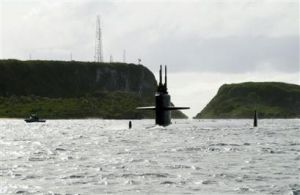
New Managing Director for Bellona Norway
The Board of the Bellona Foundation has appointed former Minister of Climate and the Environment Sveinung Rotevatn as Managing Director of Bellona No...
News

Publish date: January 12, 2005
Written by: Charles Digges
News
The USS San Francisco (SSNN 711), a Los Angeles Class fast attack submarine, was en route to Brisbane, Australia for a routine port call and was cruising at high speed at a depth of about 120 metres when it struck an uncharted underwater sea mountain on Friday, US Defence officials said in a statement released late Tuesday Oslo time.
One US Naval official later late Tuesday by Bellona Web would not comment on whether the vessel was travelling at an excessive speed for what were apparently uncharted waters, saying only that this will be revealed in the investigation.

Ashley had hit his head on a pump mechanism during the collision and never regained consciousness, even though medical teams worked to save him for three days as the sub limped back to its home port of Apra Harbour Guam, his father told the Akron Beacon newspaper.
Ashelys father, Dan, also of Akron and himself a naval veteran, told the newspaper that his son had served over four years of his five year commission with the navy, and had planned to re-enlist for another four-year stint aboard the USS San Francisco.
Dan Ashley said his son’s body is expected to be returned to Ohio by military escort on Wednesday.
US Navy Pacific Fleet spokesmen said that 23 others were being treated for broken bones, lacerations and bruises.
No environmental effects whatsoever
Most of the medical work was still being carried out aboard the USS San Francisco in port—an indication that the sub has not been extensively damages—and US Pacific Fleet command spokesman Jon Yoshishige said from Pearl Harbour, Hawaii that the submarines single reactor had suffered no damage during collision.
Lt. Arwen Consaul, a U.S. Navy public affairs officer on Guam also confirmed that there is no leak of radioactivity and there will be no environmental effects whatsoever as a result of the incident.
The sonar dome and the bow of the 109-metre-long USS San Francisco, however, where partially flooded, and the vessel arrived Sunday, Guam time, partially afloat, though under heavy naval, US coast and air escort. Despite the flooding, US Naval statements indicate the hull of the vessel is still intact, and that it was not in danger of taking on more water during its slow progress back to port.
The US navy also indicated there had been no damage to the submarines weapons systems, which include four torpedo tubes that can launch Tomahawk cruise missiles, which are capable of carrying nuclear warheads.
The US navy however, has been reluctant to say whether the submarine was carrying such weapons and, if so, whether they were so armed.
The USS San Francisco, which was commissioned in 1981, has a submerged water displacement of 6,900 tonnes and carries a crew off 137—12 officers and 115 enlisted sailors.
Another Ohio crew member lives survives with injuries
Another man from Ohio suffered injuries when he was violently tossed during the underwater collision, he told Toledo, Ohios WTOL Channel 11 news. Master Chief Bill Cramer, 38, of Findlay, Ohio, suffered cuts and bruises to his head, the channel reported and US Naval officials confirmed.
The submarine will remain in Guam while further investigations into the mishap continue. It is one of three US nuclear subs based at Apra Harbour.

The Board of the Bellona Foundation has appointed former Minister of Climate and the Environment Sveinung Rotevatn as Managing Director of Bellona No...

Økokrim, Norway’s authority for investigating and prosecuting economic and environmental crime, has imposed a record fine on Equinor following a comp...

Our op-ed originally appeared in The Moscow Times. For more than three decades, Russia has been burdened with the remains of the Soviet ...

The United Nation’s COP30 global climate negotiations in Belém, Brazil ended this weekend with a watered-down resolution that failed to halt deforest...